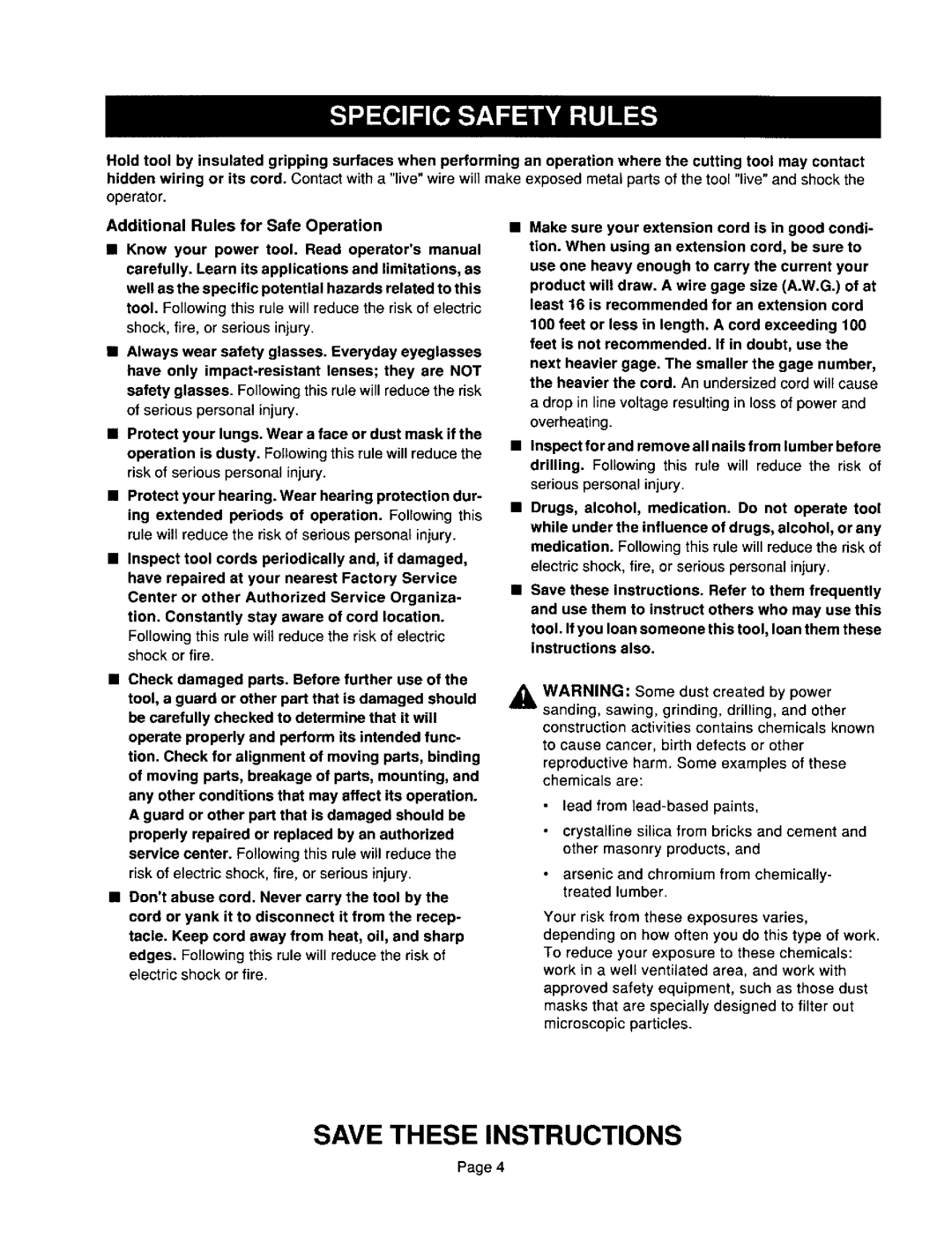
Hold tool by insulated gripping surfaces when performing an operation where the cutting tool may contact hidden wiring or its cord. Contact with a "live" wire will make exposed metal parts of the tool "live" and shock the operator.
Additional | Rules for | Safe Operation |
| • | Make sure your extension | cord is in good condi- | |||||
• | Know your power | tool. Read operator's manual |
| tion. When using an extension cord, be sure to | |||||||
| carefully. Learn its applications and limitations, as |
| use one heavy enough to carry the current your | ||||||||
| well as the specific potential hazards related to this |
| product will draw. A wire gage size (A.W.G.) of at | ||||||||
| tool. Following this rule will reduce the risk of electric |
| least 16 is recommended for an extension cord | ||||||||
|
|
|
|
|
| ||||||
| shock, fire, or serious injury. |
|
|
| 100 feet or less in length. A cord exceeding 100 | ||||||
• | Always wear safety glasses. Everyday eyeglasses |
| feet is not recommended. If in doubt, use the | ||||||||
| next heavier gage. The smaller the gage number, | ||||||||||
| have only |
| |||||||||
|
| the heavier the cord. An undersized cord will cause | |||||||||
| safety glasses. Following this rule will reduce the risk |
| |||||||||
|
| a drop in line voltage resultingin loss of power and | |||||||||
| of serious personal | injury. |
|
|
| ||||||
|
|
|
| overheating. |
|
|
| ||||
• Protect your lungs. Wear a face or dust mask if the |
|
|
|
| |||||||
• | Inspect for and remove all nails from lumber before | ||||||||||
| operation is dusty. Following this rule will reduce the | ||||||||||
|
| drilling. Following this rule will reduce the risk of | |||||||||
| risk of serious personal injury. |
|
|
| |||||||
|
|
|
| serious personal injury. |
|
| |||||
• | Protect your hearing. Wear hearing protection dur- |
|
|
| |||||||
• Drugs, alcohol, medication. Do not operate tool | |||||||||||
| ing extended periods of operation. Following this | ||||||||||
|
| while under the influence of drugs, alcohol, or any | |||||||||
| rule will reduce the risk of serious personal injury. |
| |||||||||
|
| medication. Followingthis rule will reduce the risk of | |||||||||
• | Inspect | tool cords | periodically | and, if damaged, |
| ||||||
| electric shock, fire, or serious personalinjury. | ||||||||||
| have repaired at your nearest Factory Service |
| |||||||||
| • | Save these instructions. | Refer to them frequently | ||||||||
| Center or other Authorized Service Organiza- | ||||||||||
|
| and use them to instruct others who may use this | |||||||||
| tion. Constantly stay aware of cord location. |
| |||||||||
|
| tool. Ifyou loan someone this tool, loan them these | |||||||||
| Following this rule will reduce the risk of electric |
| |||||||||
|
| instructions also. |
|
| |||||||
| shock or fire. |
|
|
|
|
|
| ||||
|
|
|
|
|
|
|
|
| |||
• | Check damaged parts. Before further use of the | ,_k WARNING: Some dust created by power | |||||||||
| tool, a guard or other part that is damaged should | ||||||||||
|
| sanding, sawing, grinding, drilling, and other | |||||||||
| be carefully checked to determine that it will |
| |||||||||
|
| construction activities contains chemicals known | |||||||||
| operate properly and perform its intended func- |
| |||||||||
|
| to cause cancer, birth defects or other | |||||||||
| tion. Check for alignment of moving parts, binding |
| |||||||||
|
| reproductive harm. Some examples of these | |||||||||
| of moving parts, breakage of parts, mounting, and |
| |||||||||
|
| chemicals | are: |
|
| ||||||
| any other conditions that may affect its operation. |
| lead from | ||||||||
| A guard or other part that is damaged should be |
| |||||||||
|
| crystalline silica from bricks | and cement and | ||||||||
| properly repaired or replaced by an authorized |
| |||||||||
| service center. Following this rule will reduce the |
| other masonry products, and | ||||||||
|
|
|
|
|
| ||||||
| risk of electric shock, fire, or serious | injury. |
| arsenic | and chromium | from | chemically- | ||||
• | Don'tabuse cord. Never carry the tool by the |
| treated | lumber. |
|
| |||||
|
|
|
|
| |||||||
| cord or yank it to disconnect | it from the recep- |
| Your risk from these exposures | varies, | ||||||
| tacle. Keep cord away from heat, oil, and sharp |
| depending | on how often | you do this type of work. | ||||||
| edges. Following this rule will reduce the risk of |
| To reduce your exposure | to these chemicals: | |||||||
| electric | shock or fire. |
|
|
| work in a well ventilated | area, and work with | ||||
|
|
|
|
|
|
| approved safety equipment, such as those dust | ||||
|
|
|
|
|
|
| masks that are specially designed to filter out | ||||
|
|
|
|
|
|
| microscopic particles. |
|
| ||
SAVE THESE INSTRUCTIONS
Page 4
